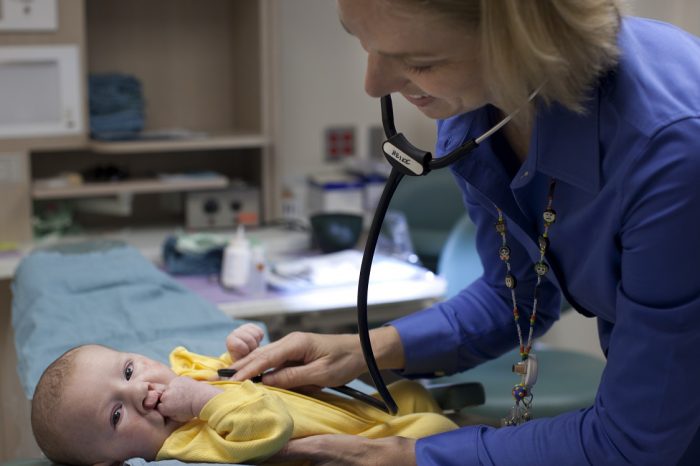 Finding out your child will be born with a cleft lip and palate can be unexpected and distressing for many families. Plagued with questions, parents may wonder if their child will be able to thrive, have speech issues, or what their smile will look like. Dr. Craig Birgfeld, a craniofacial plastic surgeon at Seattle Children’s, enjoys being able to ease a family’s anxiety. At Seattle Children’s, he knows these families are in good hands.
Finding out your child will be born with a cleft lip and palate can be unexpected and distressing for many families. Plagued with questions, parents may wonder if their child will be able to thrive, have speech issues, or what their smile will look like. Dr. Craig Birgfeld, a craniofacial plastic surgeon at Seattle Children’s, enjoys being able to ease a family’s anxiety. At Seattle Children’s, he knows these families are in good hands.
“When patients come to see us they become part of our family,” said Birgfeld. “To me, the best part of our job is seeing these kids grow up and be completely normal kids. It’s hard to remember them as a baby with a cleft. That’s the true test, and one of the reasons we do what we do.”
Why we do what we do
Earlier this year, Birgfeld was meeting with a patient family, a little boy and his mother. It had been years since the little boy had his cleft lip and palate repaired by Birgfeld, and he was doing great.
In the middle of the appointment, the mother pulled out her phone to check a message. A not-so familiar face popped up on her home screen. The child looked up at his mother and asked, “Who is that?” The photo was of the little boy as a baby with a cleft lip and palate. His big gummy smile lit up her phone. She smiled, looked down at her son with loving eyes and said, “That was you when you were a baby.”
The little boy didn’t recognize himself. His cleft lip and palate repair surgery had gone well, and he faced no challenges with speech or feeding. He was like any other boy. You would never know he was born with a cleft lip and palate if you passed him on the street.
“It filled me with pride,” said Birgfeld. “It’s very rewarding.”
An alarming trend
Unfortunately, not every story is as happy as the one above.
“We do see children who come to us after undergoing a cleft lip or palate repair from a team that doesn’t perform these surgeries often,” said Birgfeld. “It’s frustrating because the results are difficult to fix, and can sometimes lead to lifelong challenges.”
According to Birgfeld, it’s important to have a cleft lip and palate repair done correctly the first time. The more surgeries a child has to undergo, the less likely a child is to have a good outcome, and so where a child has surgery the first time matters.
After seeing a concerning rise in the number of children who come to Seattle Children’s from other centers after undergoing failed cleft lip and palate repairs, Birgfeld stresses the importance of receiving treatment at a center that specializes in craniofacial conditions.
Every year, Seattle Children’s Craniofacial Center treats hundreds of children with craniofacial conditions and rare syndromes. Cleft lip and palate is the most common condition the Craniofacial Center treats.
According to Birgfeld, families who are expecting a child with a cleft lip and palate should seek care from a multidisciplinary craniofacial center. Children with cleft lip and palate not only need surgical intervention, but also need to be seen by a number of other craniofacial specialists including pediatricians, nurses, orthodontists, speech and language pathologists and social workers. Seattle Children’s craniofacial team brings together more than 50 experts who work exclusively with children with craniofacial differences such as clefts.
“All we do is care for kids with craniofacial differences,” said Birgfeld. “When you come to Seattle Children’s, everyone you need to see is right here. We pride ourselves on being a one-stop-shop.”
The craniofacial team at Seattle Children’s performs around 220 cleft lip and palate related surgeries a year. Birgfeld says research has shown that with any surgery, surgeons who frequently perform a specific procedure often have better outcomes, and so it’s important to choose a craniofacial center that is very familiar with cleft lip and palate repairs. Each craniofacial surgeon at Seattle Children’s performs these types of procedures more than 40 times a year. At other centers, surgeons may perform the surgery once a year, and may not specialize in caring for children with craniofacial differences.
Sara Kinter, a speech and language pathologist on the craniofacial team, says reducing the number of surgeries a child must undergo is also important because more surgeries can increase the risk for poorer functional outcomes, like speech.
“We see hundreds of patients with cleft lip and palate,” said Kinter. “We think very carefully about what we recommend and why. Once you do a surgery, it can’t be undone. We do our best to maximize the best outcomes.”
To schedule an appointment at Seattle Children’s Craniofacial Center, or if you need a second opinion, call 206-987-2208.

